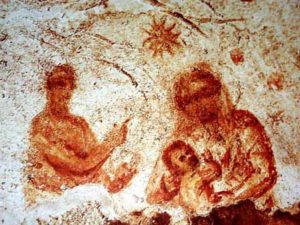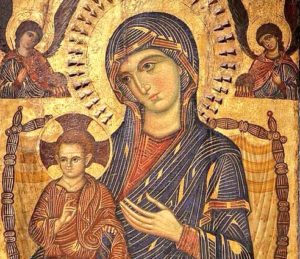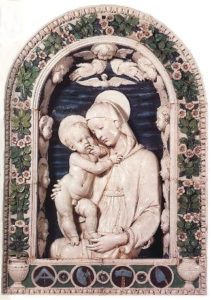1 Timothy 2:5 — The New Revised Standard Version (NRSV)
5 因為天主只有一個,在天主與人之間的中保也只有一個,就是降生成人的基督耶穌,
5 For there is one God. There is also one mediator between God and the human race, Christ Jesus, himself human,
1 Timothy 2:5 — The New Revised Standard Version (NRSV)
5 因為天主只有一個,在天主與人之間的中保也只有一個,就是降生成人的基督耶穌,
5 For there is one God. There is also one mediator between God and the human race, Christ Jesus, himself human,
https://www.earlychristians.org/the-devotion-to-the-virgin-mary-in-the-early-church Skip to content
Recent Mariological studies give evidence that the Virgin Mary has been honored and venerated as Mother of God and our Mother since the first centuries of Christianity.
During the first three centuries, the veneration of Mary was essentially included in the rites of adoration of her Son. A Father of the Church summarizes the essence of this primordial Marian cult using these words (referring to Mary): “The prophets announced you and the apostles commemorated you with the highest of praises.”
During these first centuries, only indirect testimonies of the Marian cult exist. Among them are archaeological remains of the catacombs that demonstrate the cult and veneration of the first Christians toward Mary. One of the paintings in the catacombs of Saint Priscilla represents the Virgin with her Child in her arms and a prophet, probably Isaiah, at her side. The other two paintings correspond to the Annunciation and to theEpiphany. All of the paintings mentioned are of the second century. In the catacombs of St. Peter and St. Marcellinus, one admirable painting of the third or fourth century represents Mary between Saints Peter and Paul. There, Mary is portrayed praying with her arms extended.

One magnificent demonstration of the Marian cult is the prayer “Sub tuum praesidium” (We fly to thy patronage) that dates back up to the third to fourth century, and that illustrates theintercession of Mary.
The Fathers during the fourth century praise the Mother of God in many and diverse ways.Saint Epiphanius, after combating the error of adoring Mary practiced by a sect in Arabia, writes: “Let Mary be held in honor. Let the Father, Son and Holy Ghost be adored, but let no one adore Mary.” St. Ambrose expresses the same sentiment who after giving praise to “the Mother of all virgins”, is at the same time clear and emphatic in saying that “Mary is the temple of God and not the God of the temple” to put the Marian cult in its rightful position and to distinguish it to the adoration of God.
It can be proven that during the time of Pope Sylvester, in the Roman Forum, where theTemple of Vesta used to be located, a structure was constructed bearing the advocation to “Santa Maria Antiqua” or Ancient St. Mary. In the same manner, Bishop Alexander of Alexandria consecrated a church dedicating it to the Mother of God. Moreover, it is known that Mary was being honored together with our Lord in the Church of the Nativity in Palestine since the era of Emperor Constantine, in remembrance of the miraculous conception of Christ.
Reliable ancient texts dated 225 A.D., used in the liturgical celebration of the Eucharist, mention the veneration of Mary. They also honor her during the feasts of the Incarnation, Nativity, Epiphany, etc. of our Lord. Towards 380 A.D., the first Marian feast, identified as “Memory of the Mother of God”, “Feast of the Most Holy Virgin”, or “Feast of the glorious Mother”, was instituted.
The first Father of the Church who wrote about Mary is St. Ignatius of Antioch († c. 110). He defended the veracity of the humanity of Christ against the docetists by affirming that Jesus pertained to the line of David because he was born of Mary. Jesus was conceived by Mary – He came from her – and this conception was virginal, and pertains to the most hidden mysteries in the silence of God.
In his book “Dialogue with Trypho”, St. Justin († c. 167) insists on the reality of thehuman nature of Jesus and, as a consequence of that human nature, he insists also of the maternity of Mary over Jesus. Like St. Ignatius of Antioch, St. Justin emphasizes the virginal conception. Saint Justin bases his Marian reflections on the Eve & Mary parallelism as the passage of Genesis 3:15 suggests, and this perspective which is incorporated in his theology, will serve as the basis of the Marian reflections of the later Fathers of the Church.
St. Irenaeus († c. 202), focuses on the reality of the human corporeality of Jesus and that he really came from the womb of Mary to combat the prevailing Gnostic and Docetic beliefs. Moreover, he bases on the divine motherhood his Christology: it is the human nature assumed by the Son of God in the womb of Mary that gives to the redemptive value of the death of Jesus its universality, i.e., its applicability to all men. He emphasizes also the motherhood of Mary in relation to the new Adam (Christ) and her cooperation in the work of redemption.
The north African Father, Tertullian († c. 222), during the dispute with Marcion, a Gnostic, affirms that Mary is the Mother of Christ because Jesus was engendered by Mary in her womb.

During the third century, the use of “Theotókos” (“Mother of God” in Greek) became more widespread. Origen († c. 254) was the first to apply this title to Mary. Among the prayers of supplication, the title first appeared in the prayer “Sub tuum praesidium” that, as mentioned earlier, is the oldest known Marian prayer. During the fourth century, in opposition to the doctrine of Arius, the confession of faith of bishop Alexander of Alexandria contains the same title. Since then, it gained universality and many were the Holy Fathers who reflected and studied in depth the truth that Mary is the Mother of God. Among them were St. Ephrem, St. Athanasius, St. Basil, St. Gregory of Nyssa, St. Gregory of Nazianzus, St. Ambrose, St. Augustine, Proclus of Constantinople, etc. Because of these, “Mother of God” became the most frequent title applied to Mary.
The truth of the Divine Maternity of Mary was proclaimed as a dogma of the Church in theCouncil of Ephesus in 431 A.D.
La verdad de la maternidad divina quedó definida como dogma de fe en el Concilio de Efeso del año 431.
“And after the death of the Savior? Mary is the Queen of the Apostles; she is present in the Cenacle and she accompanied them when they received what Christ had promised, the Paraclete; she supported them in their trials and she helped them overcome the obstacles that human weakness bring in along the way: she is a guide, light, and encouragement of the first Christians” (Saint Josemaría Escrivá)
The account of the devotion to Mary throughout history would not be complete if not for a third basic element: the exceptionality of the person of Mary. The affirmation of her”exceptionality” forms part of her mystery and is rooted in her sanctity which leads one to her so-called “privileges”. The bases of these “privileges” are founded on her Divine Motherhoodand her cooperation in the work of redemption. In reality, these “privileges” are gifts endowed by God so that she can carry out her unique and universal mission.
The existence of these privileges or prerogatives is not a “superfluous” doctrine nor a theological opinion. They are necessary to preserve the integrity of the Christian faith.

St. Ignatius, St. Justin, St. Irenaeus and Tertullian wrote about the virginity of Mary.Similarly, in Egypt, Origen defends the perpetual virginity of Mary and considers the mother of the Messiah as a model and help of Christians. In the fourth century, the term “aeipathenos” – ever-virgin – was introduced by St. Epiphanius in his confession of the Faith. Later, the Second Council of Constantinople proclaimed it as a Dogma of the Church.
With the affirmation of the perpetual virginity of Mary becoming more and more widespread and universal, another privilege, theabsolute holiness of the Virginwas also given emphasis. Although it had been always believed that she was incapable of sin, the possibility of Mary having had imperfections was considered at first. St. Irenaeus, Tertullian, Origen, St. Basil, St. John Chrysostom, St. Ephraim, and St. Cyril of Alexandria held this belief while St. Ambrose and St. Augustine did not accept it. After the dogmatic proclamation of the Divine Maternity of Mary in the Council of Ephesus in 431 A.D., the consideration of the privilege of absolute holiness of Mary grew stronger and was disseminated with the title “most holy” or “panagia” in Greek.
Since the fourth century, together with the privileges already mentioned (ever-virgin and most holy), the affirmation of her other privileges proceeded. Concretely, themes about her Dormitionor her Assumption, her preservation from all sin including original sin, her task as Mediatrix, and her Queenship were developed. Along these lines, St. Modest de Jerusalem, St. Andrew of Crete, St. German of Constantinople, St. John Damascene, and the Fathers of the last centuries of the patristic period who studied in depth these privileges merit special attention.
https://www.earlychristians.org/the-devotion-to-the-virgin-mary-in-the-early-church
Richard Pratt
These are tumultuous times that call for prayer and fasting. Deadly disease runs rampant; the world’s economies are unstable; peace and safety are threatened at every turn. Now, “we know that for those who love God all things work together for good, for those who are called according to his purpose” (Romans 8:28). No matter what trials we face, all of Christ’s followers “are more than conquerors through him who loved us” (Romans 8:37). Still, many of us struggle during these times as never before with hopelessness, loneliness, financial ruin, fear of violence, illness and death. The Scriptures teach that when followers of Christ face difficulties like these, we are to seek God’s help through prayer and fasting. Jesus himself explained that once he left his disciples and ascended into heaven, “then they will fast” (Matthew 9:15).
In the Scriptures, fasting is the self-denial of some or all food or drink as the faithful express their intense concerns to God in special times of prayer and worship. It was practiced both privately and corporately and for short and long periods of time. Biblical fasting occurred in many settings. God’s people mourned the death of loved ones with fasting (2 Samuel 1:11-12). They fasted to prepare for special times of renewal in the presence of God (Numbers 29:7). The faithful fasted to express heartfelt repentance over their own sins and the sins of others (Ezra 10:6). They fasted as they cried out to God in circumstances that required God’s extraordinary help (2 Chronicles 20:3). It’s no wonder then that throughout the history of the church, Christians have always turned to God in troubled times with prayer and fasting.
Sadly, modern evangelicals have largely lost sight of God’s gracious provision of fasting. We labor under the burden of thinking that the faithful will be satisfied, even delighted with whatever terrible circumstances may come their way. As a result, we deny ourselves the opportunity to express our deep sorrow over sin, our desperate need for Christ, our longing for the renewal of the church and our intense desire to see Christ’s merciful and just Kingdom spread throughout the world. Yet, as our difficult days bring us to a stark awareness of how much we need God’s mercy, we must once again humble ourselves before the Lord through prayer and fasting.
How Can My Family and I Engage in a Day of Prayer and Fasting?
First and foremost, engaging in a day of pray and fasting is a matter the heart. The Scriptures do not prescribe precisely what we are to do and say. As James put it, “Draw near to God, and he will draw near to you. Cleanse your hands, you sinners, and purify your hearts, you double-minded” (James 4:8). Above all, we are to find ways to humble ourselves before the Father, in Christ’s name and in the power of Holy Spirit.
You can do this in many ways. If you have children, you may simply lead your entire family in special times of prayer as you fast during one or more meal times. One parent may care for the children as the other spouse has time alone with God. Couples may alternate between praying in solitude and praying together throughout the day. You may also be able to connect with other Christians outside of your home for a time of prayer sometime during the day. The variety of biblical examples indicates that God grants us much freedom.
Still, I have discovered through the years that many evangelicals today find it quite challenging to spend an entire day in prayer and fasting. So, let me offer two simple, practical suggestions.
Before the Day of Prayer and Fasting
Plan how you will devote yourself to a day of prayer and fasting.
For example:
Blessings of God in your personal life
Blessings of God to your family members
Blessings of God in the lives of your friends and acquaintances
Blessings of God in your church
Blessings of God in your nation
For example:
Your own sins and personal needs
The needs of family members by name, especially the elderly and sick
The needs of friends and acquaintances by name, especially the elderly and sick
The renewal of your church and church leaders in Gospel ministry
Blessing and protection for medical professionals
Wisdom for specific government officials
On the Day of Prayer and Fasting
Repeat a similar process throughout the day of prayer and fasting.
Based on Excerpts from Pray with Your Eyes Open by Richard L. Pratt, Jr., President of Third Millennium Ministries.
PCA Administrative Committee
1700 North Brown Road
Suite 105
Lawrenceville, GA 30043